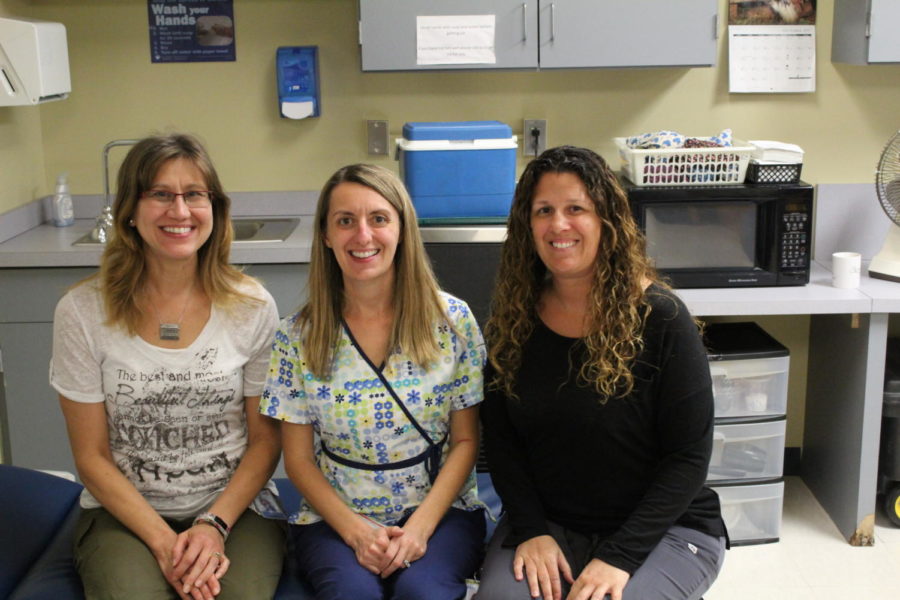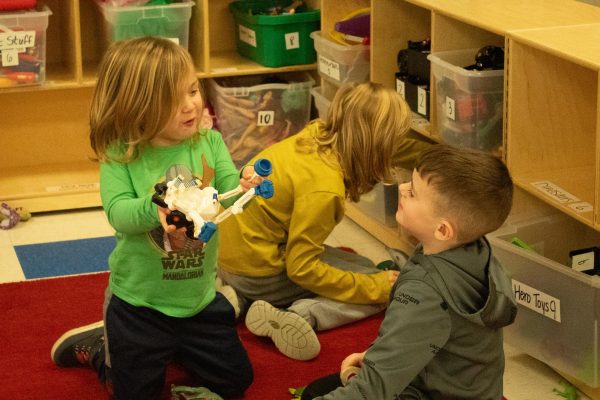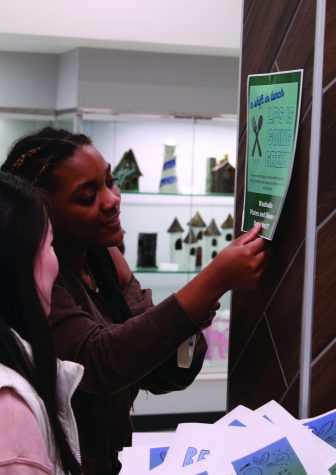Disease Prevention
LHS nurses promote healthy habits and prevent illnesses through various practices.
Not all heroes wear capes but some do wear scrubs and carry stethoscopes.
The LHS nurses administer medicine, conduct vision, hearing and scoliosis screenings, promote good hygiene to students and also work with a “disease surveillance” program. This program is a forum for the nurses to document and inspect common symptoms students show and take control of health issues that may come up.
That’s our goal,” LPS Director of Health Services Kathy Ellermeier said. “To help support learning in the classroom.”
Few know about what all the school nurses do for the school, even fewer know about the disease surveillance partnership LHS has with the Clay County Public Health Center. Every week for the past 12 years, the epidemiology team at the Clay County Public Health Center has gathered data from the 60+ schools in the county to monitor the trends in school illnesses.
Epidemiology deals with the occurrence, movement and control of disease. When working with the epidemiologist, the school nurses submit data of symptoms students show and in turn receive an analysis and report of those issues in relation to numbers from five years ago.
The symptoms that are documented and analyzed are fever, diarrhea, vomiting, respiratory issues, sore throat, rash, headache, asthma and stomach ache. Each report is broken down by each symptom, each school district and each school.
“Usually we have a 90% or better response rate,” Epidemiologist specialist Lizzie Groenweghe said. “That means out of the 65 schools that are in Clay County usually about 90% or more will send a report.”
This disease program is actually larger than the schools, it even extends to emergency rooms in Clay County, including Liberty, North Kansas City, Saint Luke’s, Excelsior Springs and Children’s Mercy Hospital. Those numbers, classified as the “Essence report,” are used in comparison to the schools to find any correlations.
“Our next goal is to expand to the daycares as well,” Groenweghe said. “If you think about it, we all kind of intermingle in the way that we live our lives. A family might have one kid that’s in high school, another in middle school and another kid that’s in daycare. They’re all sharing those germs together.”
With everyone sharing their germs, an outbreak is to be anticipated. An outbreak at the school/district would constitute about a 20-30% population of the school being sick. It’s never happened at Liberty Schools but did happen last year in another school where half of the class was out with vomiting and diarrhea.
Once all the numbers and data is inspected and finalized, the school nurses make a plan to curb and prevent any unusual activity on the charts. If an outbreak occurs, then an investigation will follows suit. Steps of action depend on the situation.
“If it’s maybe a vaccine-preventable disease like a chickenpox outbreak or a pertussis outbreak, we’ll try to figure out who else has been exposed and if they’ve been vaccinated,” Groenweghe said.
Following an investigation is a plan to prevent the spread of that specific illness/symptom.
“Some of the prevention tactics for curbing the spread of illness in our schools are good handwashing, hygiene measures, and covering your cough or cough-etiquette,” Ellermeier said. “Handwashing is the number one best prevention, it is so simple, everyone can do it but you’d be surprised at the people who don’t think about it.”
Ellermeier also said that while it’s understandable that a student tries to be at school even when they’re sick, it’s more important that their health needs are met first and that they stay home.
Recently, the disease surveillance program won an award for their model practice at the National Association for City and County Health Organizations, or, NACCHO conference.
“This partnership that we have with Clay County Public Health Center is a really strong and special one,” Ellermeier said. “It speaks a lot to how much we value and care about our community and our people living here.”
Vaccines for Life
400 million, that’s how many people were killed by smallpox from 1900-1999, since then, not one single person has died of smallpox. Why? Vaccines. When vaccines are brought up, people, especially students, may not know what they do or why they are important.
“I know they are required to keep people alive, they keep diseases away,” senior Callisa Broyles said. “I know about the flu shot, that’s it.”
Vaccines prevent someone from getting serious and deadly diseases that could be prevented, smallpox being one of them. Besides smallpox there are tons of diseases that are preventable. Some of the vaccines that students are required to get are Polio, Hepatitis B, and Meningitis.
In a student poll, a majority exceeding 75 percent of the 195 responses were in favor of vaccines and immunizations, along with schools requiring students to be vaccinated.
Some people do not or cannot get vaccinated. The only two legal reasons that someone may not be vaccinated are a medical condition or a religious exemption. If someone believes they cannot get a vaccine, they should speak to their doctor, who will figure out what is best for them. When people do not get vaccinated they put themselves and others at risk for serious diseases that could be prevented. These students are allowed to attend school, however if there is an outbreak of a disease, they will not be allowed to attend school.
In today’s society, there are some misconceptions and controversy about vaccines. Some people believe that vaccines will give their children disabilities, such as autism.
“With any vaccine there are minor side effects, the downside is more not being vaccinated,” nurse Karla Hausman said.
The misconceptions tend to happen because around the time children get the bulk of their vaccines is also the time the symptoms of disabilities may start to show. Vaccines has eradicated many diseases that people used to fear daily.
“Years ago parents used to fear their child might develop Polio, which can result in paralysis or even death,” Hausman said. “Now with us vaccinating against Polio, there are no reports of Polio in the United States.”
When getting a vaccine, insurance will cover the cost to administer it. If a family does not have insurance there are still options.
“The health department will work with you,” Hausman said. “They do have a small fee for administering the vaccine but they do not turn away people. They will work with anyone who needs to be vaccinated.”












